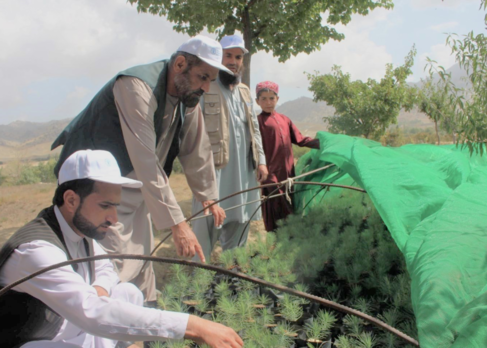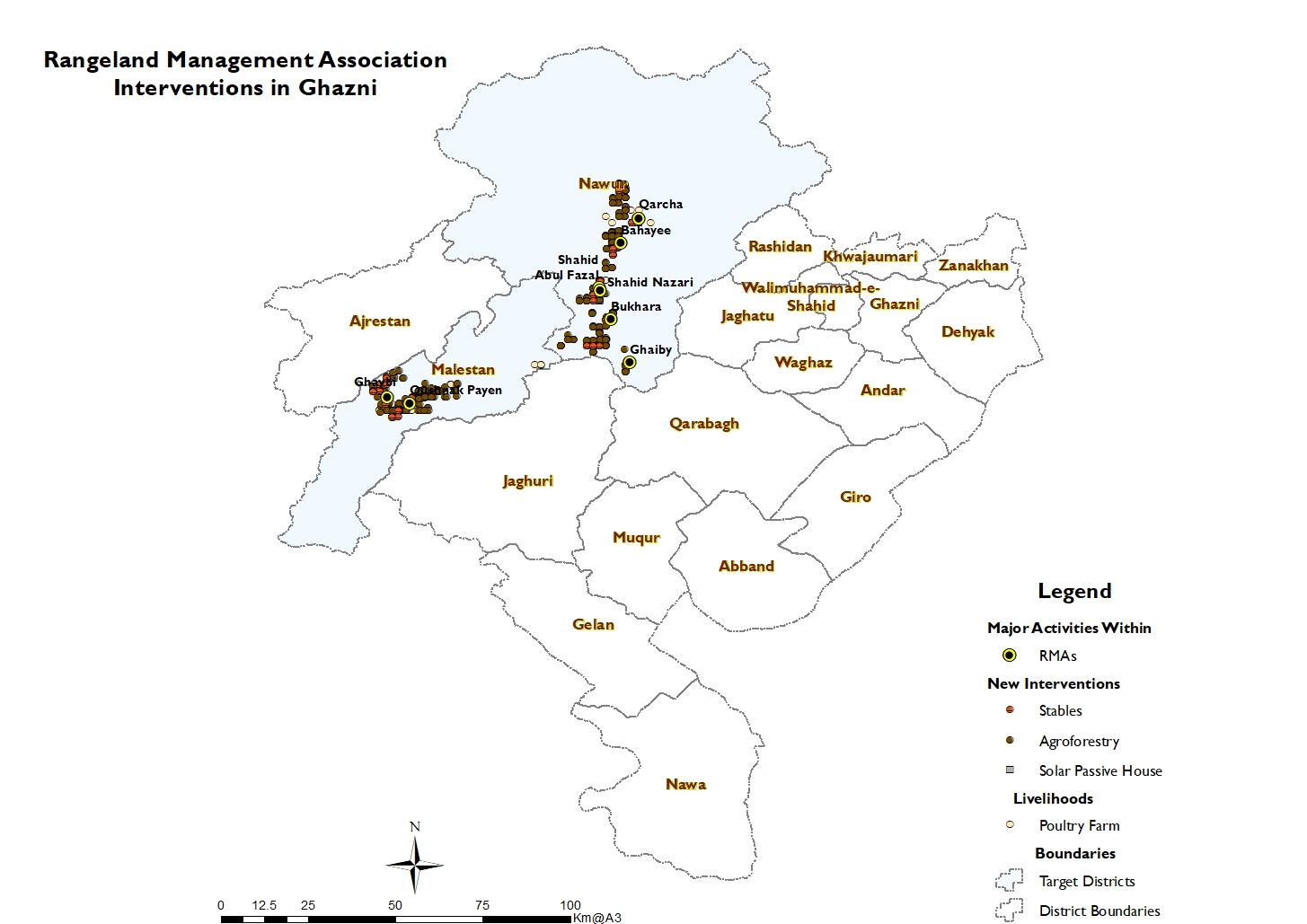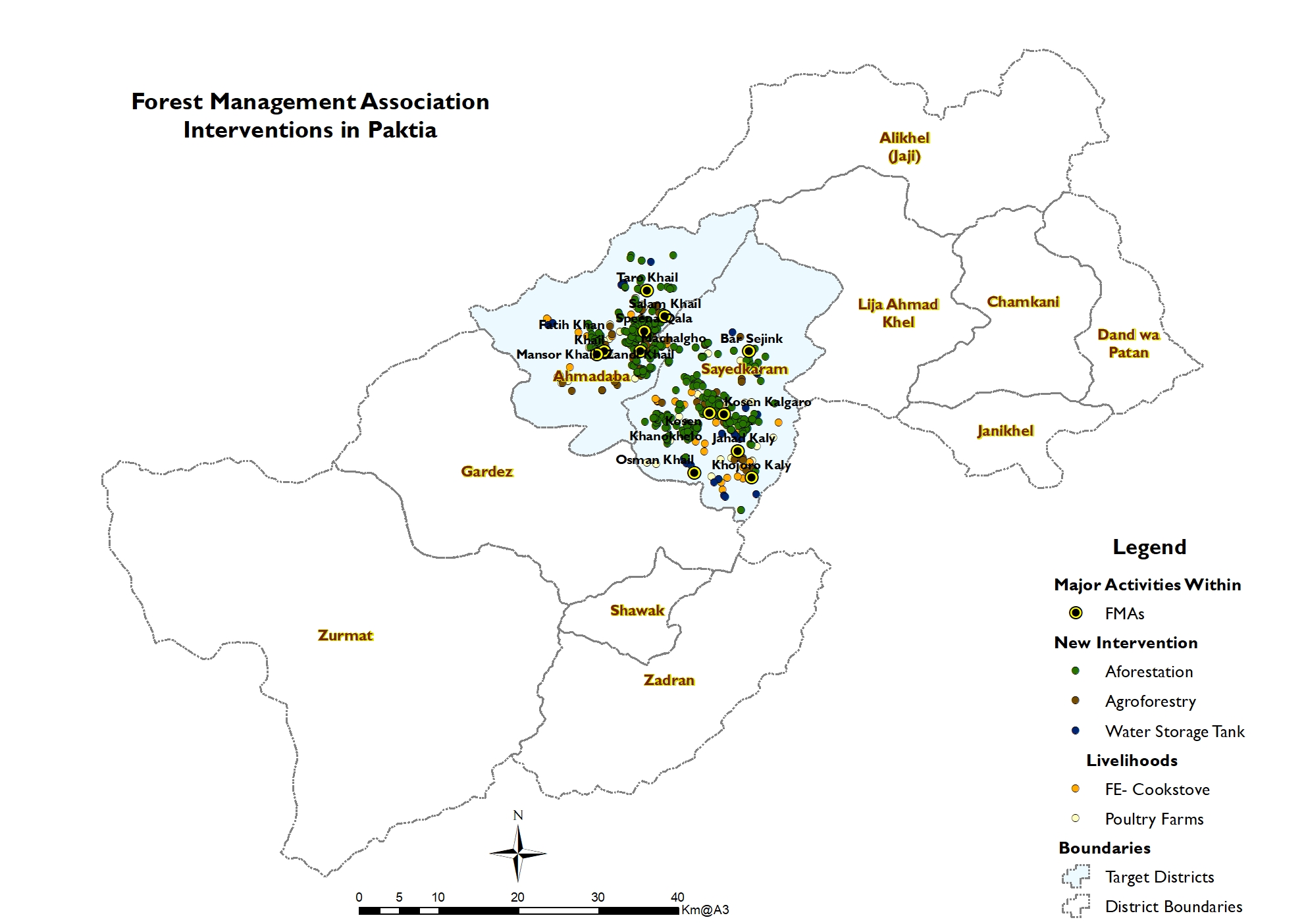Forest and Landscape Restoration Asia
FLR Afghanistan Knowledge Hub
Monitoring and Evaluation
FAO GEF projects in Afghanistan apply a participatory and community-based M&E approach which involves key stakeholders in the design, implementation, monitoring, and evaluation of the project. FAO/GEF conducts M&E activities at three levels: implementation monitoring, output monitoring, and outcome monitoring.
The community-based monitoring is based on the long-term plan that the community had committed in the CBNRM document. A community monitoring committee (CMC) is established under each FMA/RMA through which 3-5 assigned local people monitor the progress of works and the interventions qualitatively and quantitatively. The M&E team uses various tools and checklists to collect and report data and works closely with CMC members to ensure transparency, efficiency, effectiveness, and sustainability of the project.

Monitoring community nursery
Project areas






Project Objective To support integrated, community-based approaches to sustainable land and forest management in Afghanistan for promoting biodiversity conservation, climate change mitigation and rangeland productivity | Indicators
|
| Outcome 1.1 Enhanced capacity of sectorial stakeholders (Forest Management Associations, Rangeland Management Associations, target community members, and other relevant stakeholders) in district and provincial level for SLM/SFM |
|
Output 1.1.1.Knowledge management hub for Natural Resource Management’ established for coordinating the capacity development and knowledge management on SLM/SFM at all levels |
|
Output 1.1.2. Training programme developed and delivered to Forest Management Associations, Rangeland Management Associations, target community members, and other relevant stakeholders in district and provincial level on land degradation assessment and planning for integrated SLM/SFM |
|
Output 1.1.3. Fine-scale inventory of forest and rangeland resources – including ecosystem goods/services, rangeland/forest condition and socio-ecological resilience – undertaken for Badghis, Bamyan, Ghazni, Kunar and Paktya provinces |
|
Output 1.1.4. National REDD+ Readiness Roadmap formulated |
|
Outcome 1.2. Enhanced capacity of local communities in Badghis, Bamyan, Ghazni, Kunar and Paktya provinces for developing and implementing community-based SLM/SFM plans |
|
Output 1.2.1 Resource materials on local-level planning, implementation and M&E for SLM/SFM developed, based on the LADA-WOCAT and other relevant tools |
|
Output 1.2.2 Training provided to local-level technical government staff on facilitation of community-based planning and M&E for SLM/SFM as well as best practices for inter alia animal husbandry, rangeland management, forest conservation and sustainable resource use |
|
Output 1.2.3. Awareness-raising campaign conducted on community-based and gender-sensitive SLM/SFM planning, implementation and M&E |
|
Output 1.2.4. Forest Management Associations (FMAs) and Rangeland Management Associations (RMAs) supported to develop participatory, community-based and gender-responsive SLM/SFM plans |
|
Output 1.2.5. Pastoralist field schools conducted on livestock husbandry and community-based rangeland management/SLM practices |
|
Outcome 2.1 Restoration and improved management of 30000 ha of HCVFs and other forest types to increase biodiversity conservation and sequester 1,530,069 tCO2e in Badghis, Kunar and Paktya provinces |
|
Output 2.1.1. Biodiversity assessments undertaken in HCVFs in Kunar and Paktya provinces |
|
Output 2.1.2. Community nurseries and woodlots established to support assisted natural regeneration and provide sustainable timber and non-timber forest products to reduce pressure on forest resources in Badghis, Kunar and Paktya provinces |
|
Output 2.1.3. Assisted natural regeneration, rehabilitation/ restoration and SFM implemented over 10,000 ha of HCVFs (Kunar and Paktya) and 20,000 ha of other forest types (Badghis) leading to an overall increase in vegetative cover over the landscape and improved connectivity between forest patches |
|
Output 2.1.4. Diversified livelihood options promoted to reduce pressure on forest resources, including agro-forestry, alternative energy sources and value addition for timber and non-timber forest products in Badghis, Kunar and Paktya provinces |
|
Outcome 3.1 Climate-resilient SLM practices implemented across 200,000 ha of degraded rangelands in Badghis, Bamyan and Ghazni provinces |
|
Output 3.1.1. Climate-resilient SLM interventions – including soil and water conservation, rotational grazing and restoration/ rehabilitation with palatable species – implemented over 200,000 ha of degraded rangelands |
|
Output 3.1.2. Enhanced livelihoods through strengthened value chains for products from livestock husbandry |
|
Outcome 4.1. Improved knowledge to inform planning and implementation of SLM/SFM practices |
|
Output 4.1.2. Local-level, participatory M&E system for SLM/SFM established for monitoring of rangeland and forest condition, including biodiversity conservation and carbon sequestration |
|
Output 4.1.3. Best-practice guidelines on rangeland and forest restoration and management developed and disseminated |
|
Output 4.1.4. Lessons learned on SLM/SFM practices in Badghis, Bamyan, Ghazni, Kunar and Paktya provinces collated and disseminated nationwide as well as regionally |
|
Output 4.1.5. Mid-term review (MTR) and Terminal Evaluation (TE) conducted |
|
Interventions in the project areas include afforestation, reforestation, agroforestry, stable improvement, establishment of woodlots, nurseries, and solar passive houses, construction of check dams, water reservoirs, terracing, distribution of fuel-efficient cock stoves, dairy hygiene kits, fertilizers, and seeds. Moreover, certain areas are quarantined to improve the management of rangeland and forests for conserving biodiversity. Further, the project capacitates the forest and rangeland users in the target communities to better manage and optimize land and forest uses.
Project Ecosystem Restoration Monitoring is integrated in the FERM which is a global platform to monitor ecosystem restoration (FORTHCOMING)

View FAO GEF-6 Dashboard
Last Update: November 2023
GEF-7 M&E



The volunteers in the field use KoboToolbox to collect, analyze, and manage data for monitoring and evaluation.
Related Interactive Maps
View FAO GEF-7 Dashboard
 Last Update: November 2023
Last Update: November 2023

.png?sfvrsn=bf69a908_0)